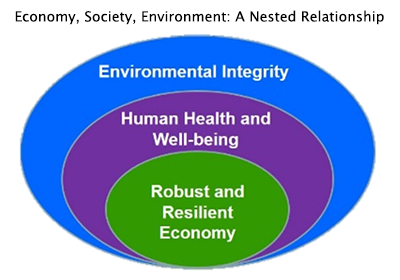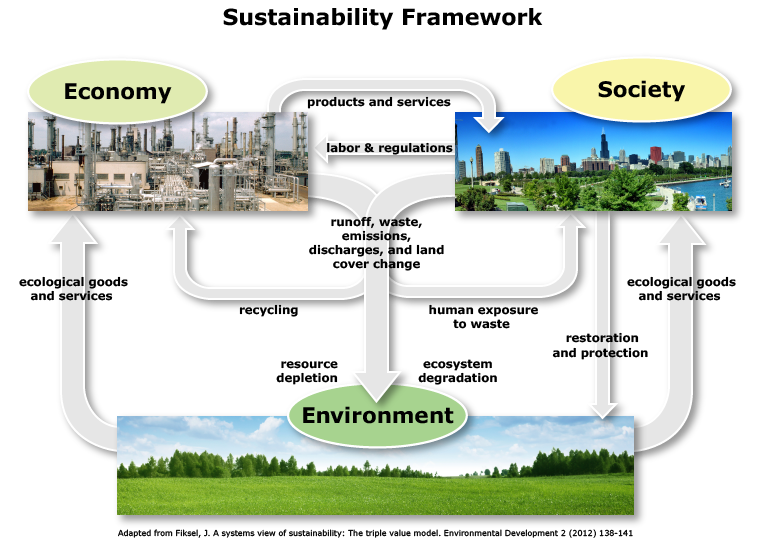Sustainability and the ROE

What is sustainability?
Sustainability is about meeting today's needs without compromising the ability of future generations to meet their needs. It is about taking action to protect our shared environment—air, water, land, and ecosystems—in ways that are economically viable, beneficial to human health and well-being, and socially just in the long term.
“Sustainability” is not a new term. In 1969, the National Environmental Policy Act (NEPA) made sustainable development an ongoing policy priority of the federal government, with the goal to “create and maintain conditions under which humans and nature can exist in productive harmony, that permit fulfilling the social, economic and other requirements of present and future generations.”
In practice, sustainability refers to efforts to align economic development with environmental protection and human well-being. Sustainability is commonly characterized in terms of the interdependence among three broad dimensions—environment, economy, and society—while considering both present and future generations. The diagram represents these dimensions as nested, with a resilient and robust economy existing within a healthy society dependent on an intact and functional environment. Because of sustainability's increasing importance to EPA, the Agency has added this “Sustainability and the ROE” section to the ROE to provide ROE users with a brief introduction to the topic and a systems-level approach to conceptualize the connections between ROE indicators.
Why is sustainability in the ROE?
As EPA works to identify and pursue solutions to achieve environmental outcomes with optimal economic and social outcomes using sustainability principles, the ROE has an important role. As a source of information about trends in the condition of the U.S. environment and human health, the ROE indicators can inform decision-making when the desired outcome must balance human health, environmental, social, and economic risks and benefits.
The ROE will continue to focus on scientific indicators that inform five mission-driven themes (Air, Water, Land, Human Exposure and Health, and Ecological Condition). Over time, though, EPA will integrate sustainability-related questions with the existing ROE themes and add new indicators to address aspects of sustainability relevant to EPA's mission. In this version of the ROE, most of the indicators address environmental conditions and some address social (human health and exposure) conditions. Although none of the current indicators directly addresses economic conditions, several indicators have been added to address natural resource consumption; these have an economic component (see Energy Use, Freshwater Withdrawals, Municipal Solid Waste, and RCRA Hazardous Waste).
The ROE includes a systems-based sustainability framework that depicts some of the relationships among the three dimensions of sustainability. The framework is useful to illustrate how ROE indicators can be integrated into sustainability and to conceptualize important causal connections between quantitative ROE indicators (e.g., Volatile Organic Compounds Emissions) associated with the underlying system elements (e.g., transportation) and attributes (e.g., vehicle emissions). These are just first steps toward providing new information that supports sustainability-based environmental protection.
Why is a sustainability framework useful?
Since the concept of sustainability, or sustainable development, is based on the fundamental interdependence between human and natural systems, EPA has adapted for the ROE a systems approach that illustrates the linkages among the three dimensions (environment, society, economy) of sustainability. This approach is illustrated in the conceptual framework in the figure below, which shows how the environmental, economic, and social dimensions of the broader human ecological system are interrelated.
Human decisions related to any of the three dimensions affect the entire system. Using this framework can help identify the critical relationships among these system dimensions. ROE indicators can be used to inform decisions based on these complex relationships, and this framework can help identify gaps where new indicators could be developed.
The conceptual framework shown below represents the world as three interrelated, interdependent, interacting dimensions of our human-ecological system: environment, society, and economy. The arrows in the figure show the flows among the three dimensions.
About the Three Dimensions of Our Human-Ecological System
- The environment represents the natural world, including native animals and plants, mineral deposits, soil, water, and air.
- The economy comprises activities that provide products and services to people. These include manufacturing, agriculture, mining, power generation, drinking water treatment, wastewater treatment, solid waste management, health care, construction, and commercial fishing and aquaculture.
- Society represents people, their actions, and their quality of life. This includes human health and well-being, government and other institutions, buildings, transportation and utility infrastructure, and recreation.
Interrelationships Among the Dimensions of Our Human-Ecological System
- The environment provides ecological services to the economy and to society. Examples include provision of goods such as fish, crops, air, water, timber, raw materials, and fuel; purification of air and water; pollination of crops and natural vegetation; maintenance of biodiversity; decomposition of wastes; moderation of weather extremes; contribution to climate stability; and provision of recreation.
- The economy produces products and services for society. It deposits wastes into the environment, and can also protect and restore environmental systems through recovery and recycling operations.
- Society supplies labor and talent to the economy. It generates wastes that are deposited in the environment or recycled to the economy. It regulates the economy and protects the environment.

